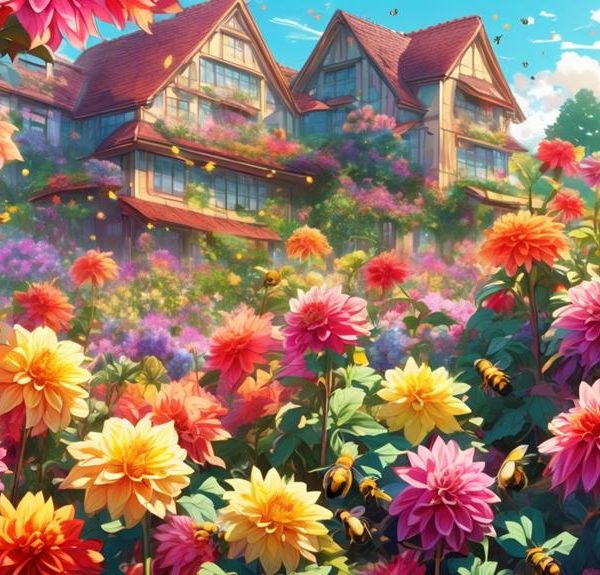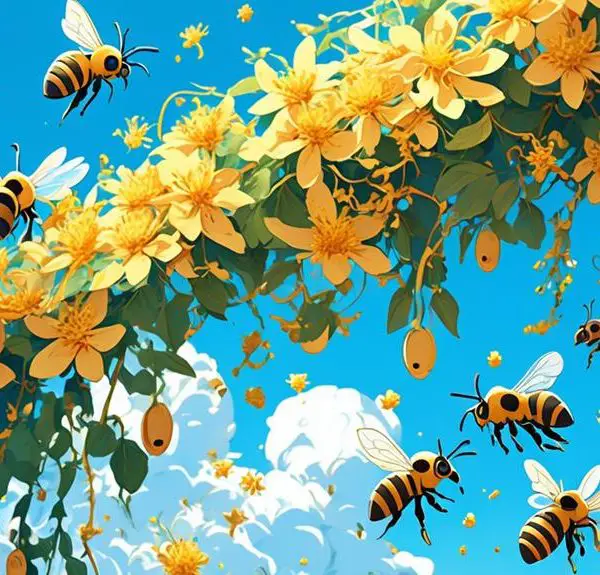An intriguing exploration into the complex relationship between bees and the vibrant forsythia blooms, revealing surprising insights into garden ecology.
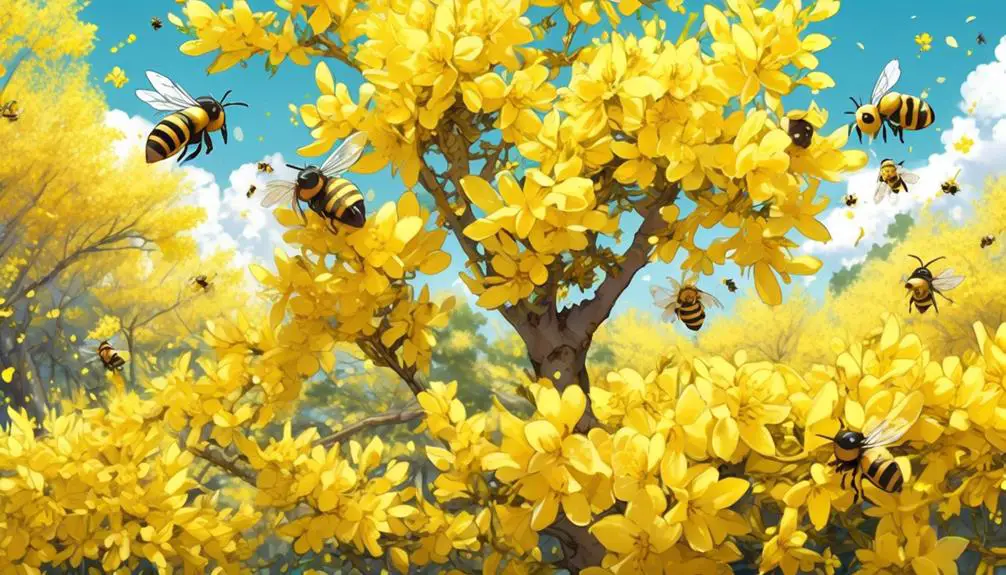
Do Bees Like Forsythia?
Have you ever wondered if bees enjoy the bright yellow blooms of the forsythia? As you stroll through your garden, you might notice these buzzing creatures flitting from flower to flower, seemingly drawn to the vibrant forsythia blossoms. This might lead you to question if there's a particular attraction between this plant species and our winged pollinators.
While it's true that bees are attracted to many flowering plants, the relationship between bees and forsythia is not as straightforward as it seems. There's more to this than meets the eye, which could drastically change how you view your garden.
Why not explore further to reveal the complex relationship between bees and forsythia?
Key Takeaways
- Forsythia is a reliable source of nectar and pollen for bees, providing them with essential nutrients for colony growth.
- Bees unintentionally assist in the reproduction of forsythia through cross-pollination, increasing genetic diversity.
- Forsythia's early bloom coincides with the awakening of bees, ensuring a timely and vital food source for their survival.
- To attract bees with forsythia, plant it in a sunny location, near other nectar-rich plants, and avoid over-fertilization.
Understanding Forsythia: A Brief Overview
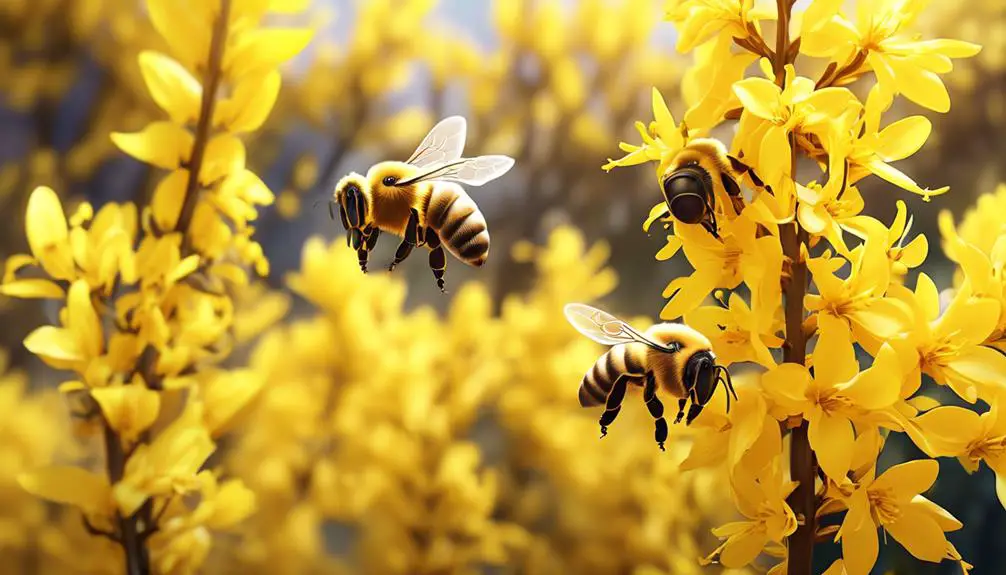
To truly appreciate the allure bees find in forsythia, you first need to grasp the fundamental characteristics of this vibrant, early-spring flowering plant. Forsythia, a deciduous shrub, captivates with its brilliant yellow blooms, which are among the first to appear as winter recedes. Its flowers aren't just eye-catching; they're also a rich source of nectar and pollen, crucial sustenance for bees emerging from hibernation.
Now, consider the plant's hardy nature. Forsythia isn't fussy about soil type or exposure, and it's resilient to pests and diseases. This means it's a reliable, long-term food source that bees can count on.
As you delve deeper into the behavior of bees, you'll find they're not just looking for food. They're also seeking plants that provide shelter and breeding grounds. The dense, arching branches of the forsythia fulfill these needs, offering protection from predators and a safe place for bees to raise their young.
Bees and Pollination: How It Works
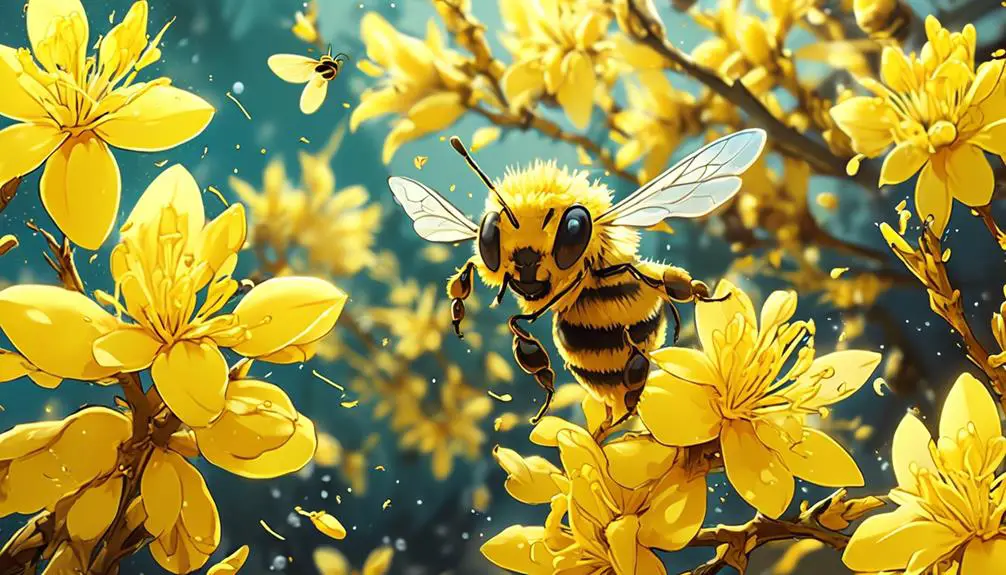
Building on the forsythia's vital role as a food and shelter source for bees, it's crucial to understand how these industrious insects interact with plants through the process of pollination. You see, when a bee lands on a forsythia bloom, it's not just feasting on the nectar; it's acting as a crucial bridge between male and female plant parts.
As the bee moves from flower to flower, pollen grains from the male parts (stamens) of the flower stick to its hairy body. When the bee visits the next flower, some of this pollen rubs off onto the female parts (pistils) of the flower. This transfer, known as cross-pollination, is how plants reproduce and create seeds.
Forsythia flowers, specifically, are hermaphroditic, meaning each flower has both male and female parts. So, every visit from a bee has the potential to fertilize and create new seeds for the next generation of forsythia. Without the bee's unintentional assistance, the chances of successful pollination dramatically decrease.
Forsythia and Bee Interactions
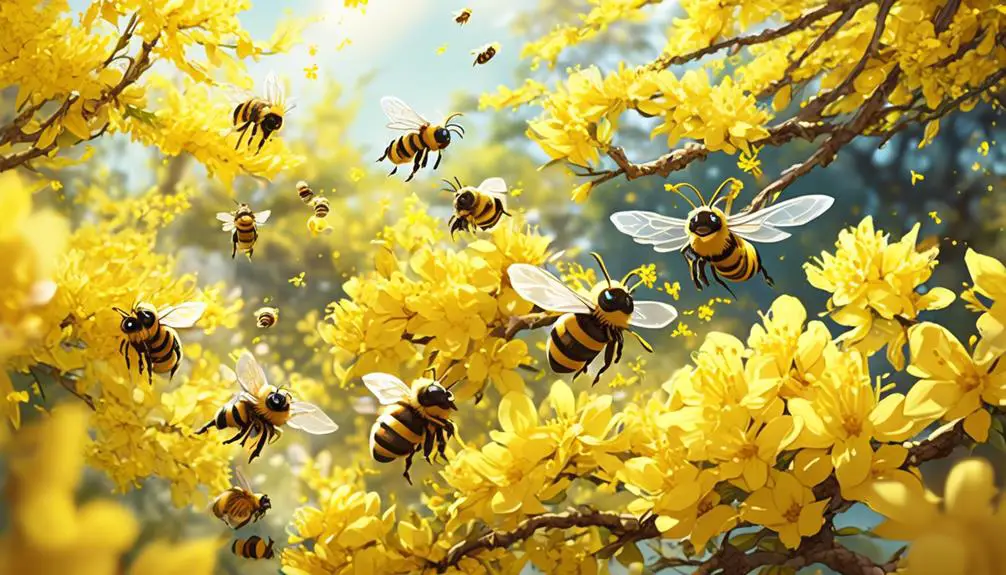
When observing the interaction between bees and forsythia, you'll find a dynamic and crucial relationship that significantly contributes to both the survival and prosperity of each species. Forsythias, with their vibrant yellow blooms, are an early spring source of nectar and pollen for bees. As they emerge from winter, forsythia's flowers provide crucial sustenance for bees, thus aiding their early reproduction and colony growth.
In turn, bees play a vital role in forsythia reproduction. As bees forage for nectar, they inadvertently collect pollen on their bodies, which they then transfer from the male parts of a flower to the female parts of another, hence facilitating cross-pollination.
Here's a table that further illustrates their mutualistic relationship.
Forsythia Benefits | Bee Benefits |
|---|---|
Pollination, aiding reproduction | Early spring source of nectar and pollen |
Increased genetic diversity through cross-pollination | Nutrients from pollen aid in colony growth |
Bees help spread forsythia to new areas | Forsythia's early bloom provides food when other sources are scarce |
Their interaction is a classic example of a symbiotic relationship in nature, where both parties benefit, demonstrating the interconnectedness of our ecosystem.
Importance of Forsythia for Bees
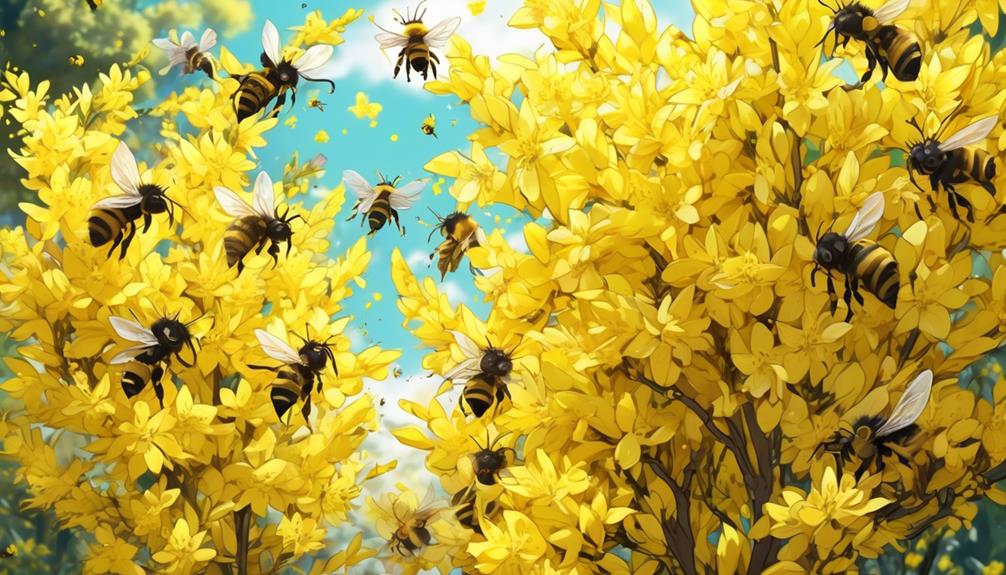
Why is forsythia so vital to bees, you might ask? This early spring bloomer isn't just a pretty sight; it's a lifeline for bees emerging from their winter slumber. When other food sources are scarce, forsythia's bright yellow flowers provide bees with early season nectar and pollen, crucial for their nutrition.
Analyzing this relationship closely, you'll notice that forsythia's blossoming coincides with the awakening of bees. It's not a coincidence, but a testament to nature's intricate synchronicity. When bees need food the most, forsythia is there to provide it. It's a survival mechanism for both parties.
Bees get the nourishment they need to kick-start their season and, in return, they pollinate the flowers, ensuring the plant's reproduction.
Ways to Attract Bees With Forsythia
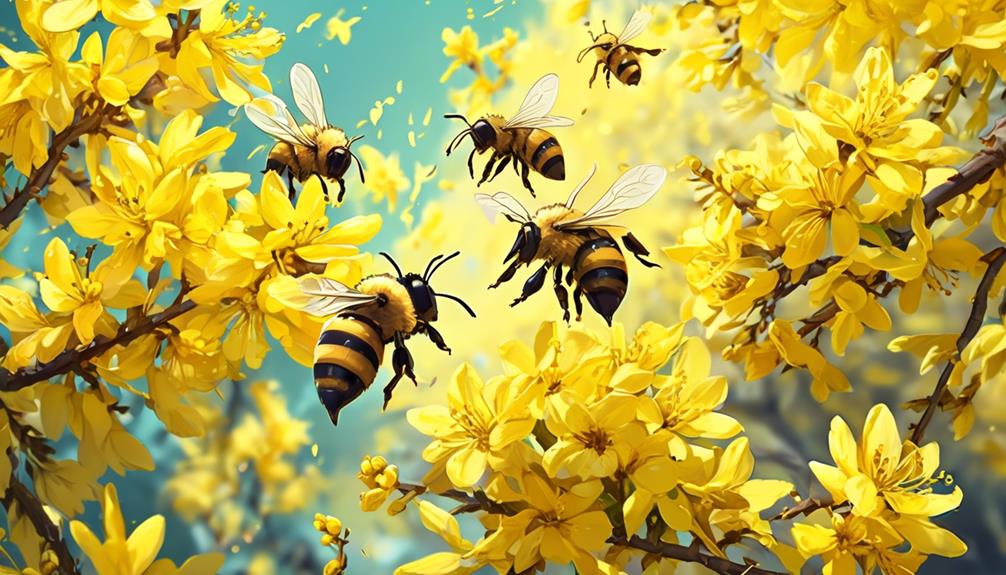
To draw bees to your garden using forsythia, you'll need to strategically plan its placement and care, ensuring that these vibrant blooms are an irresistible early spring source of nourishment for these essential pollinators.
Forsythia should be planted where it can receive at least six hours of sunlight each day. Bees are drawn to sunlight and the warmth it provides. Moreover, place your forsythia near other nectar-rich plants to create a bee-friendly buffet that will keep the pollinators returning.
When it comes to care, don't overdo it. Bees prefer flowers in their natural state, and too much fertilization can make the nectar less appealing. Prune your forsythia after it blooms to maintain its shape and promote robust growth for the next year's bloom.
Frequently Asked Questions
How Do Bees Contribute to the Reproduction of Forsythia Plants?
You might be wondering how bees aid in the reproduction of forsythia plants. Well, it's quite simple! As bees flit from flower to flower, they're gathering nectar.
In doing so, they inadvertently pick up pollen grains which get transferred to the next flower they visit. This is known as cross-pollination, and it's essential for the reproduction of many plant species, including forsythia.
What Are the Potential Dangers of Bees to Forsythia Plants?
You might be surprised to learn that bees don't pose any real danger to Forsythia plants. In fact, they're beneficial.
Bees are pollinators and they help in the reproduction process of these plants. The only potential risk could be if the bees are carrying a plant disease, but that's quite rare.
Are There Any Other Insects That Are Attracted to Forsythia Apart From Bees?
Yes, there are other insects attracted to Forsythia besides bees.
Butterflies, such as the Peacock and Brimstone, are often seen fluttering around these plants.
Various beetles and aphids also find Forsythia appealing.
It's important to monitor your plants for these creatures, as they can sometimes cause damage.
How Can One Protect Forsythia From Pests While Still Attracting Bees?
You can protect your forsythia while still attracting bees by using organic pesticides. They're less harmful to beneficial insects like bees.
Also, consider introducing beneficial bugs, such as ladybugs and lacewings, that naturally control pests.
Regularly inspect your plants for signs of infestation and prune any affected areas.
What Is the Best Time of Year to Plant Forsythia for Maximum Bee Attraction?
You're wondering when's the best time to plant forsythia to attract the most bees.
It's best to plant forsythia in the early spring or fall. This timing gives the plant a chance to establish itself before blooming.
Come springtime, it'll burst into vibrant yellow flowers. The bloom period, typically early to mid-spring, coincides with the emergence of bees, making your forsythia a bee magnet!
Conclusion
In a world buzzing with life, you've seen how bees and forsythia interact. Bees adore forsythia's early bloom, making it crucial for their survival.
By planting forsythia, you're not just enhancing your garden's beauty, but also playing a part in bee conservation.
So, go ahead, let your garden be a beacon for these industrious pollinators. Remember, a world buzzing with bees is a world thriving with life.

